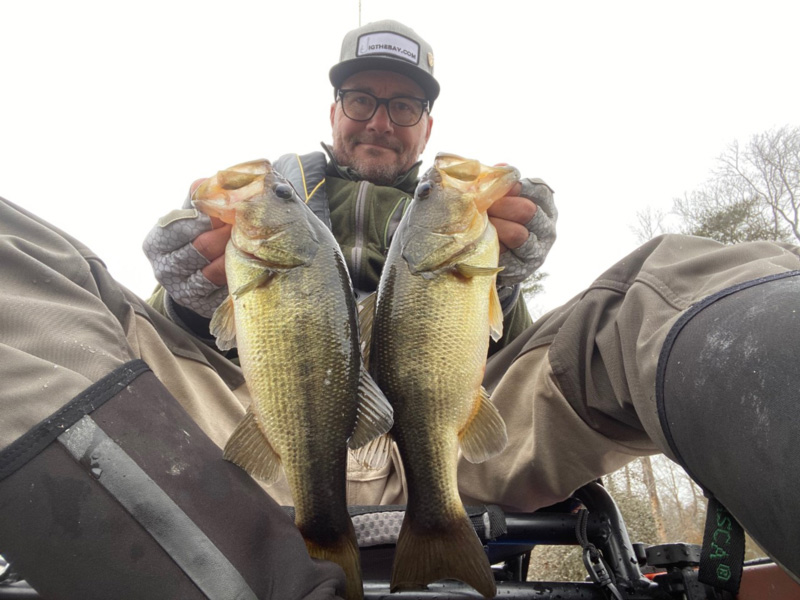When most anglers are stowing their tackle for a long a winter nap I’m getting mine ready for the next kayak fishing outing to a local lake, pond, or stream. I fish year-round and in most all weather. Now don’t get me wrong, safety is first and foremost in my mind. I don’t fish out of my kayak when the wind speed is over 13 mph, when a pending storm is in the area, or if the roads are too bad to drive to my spot of choice. I simply stay home, maybe repair some tackle, and pout.

Okay enough of that, lets go fishing. If you’re reading this article you are most likely a kayak fisherman, and you know fishing can be frustrating out of your yak at times. Making a cast and landing your bait into a spot no bigger than a dinner plate on a windless summer day is one thing, but now lets add a cold breeze in 35-degree temperatures with the sun low in the sky, reflecting off the water. Now try to hit that mark.
On a recent outing I was dealing with just that, and trying to put most of it out of my mind, concentrating on the hunt. Well, I was actually pickerel fishing not bass fishing, but what the heck, the bass were breaking the water all around me. So I switched up and tied on my go-to bait, a quarter-ounce jig with a four-inch transparent light blue paddle tail. Then I waited, looking around for movement on the surface of the lake. Heck yea, now believe me, when you’re fishing the Eastern Shore millponds, expect to see fish leaving telltale signs on the waters surface. Millponds such as Urieville, Unicorn, Tuckahoe, and Smithville are shallow enough that if a fish makes a move to feed you have a good chance of seeing it.
To my right and behind me I hear a splash, so I turn and take a cast to where the water was disrupted. I feel a bump, set the hook, and a 20.5-inch largemouth bass takes a dive and runs at me. I fight the fish to the boat, release, and repeat. Another cast towards another disturbance on the water’s surface, another bass. In all I caught four bass between 17 and 20.5 inches in quick succession on this day, before I figured I’d better focus and continue on my search for my target fish, the pickerel. I was fishing the CCA Pickerel Championship, so best get back to business.
Wintertime bass fishing can be tough and you will come home skunked on occasion, but keep at it. For me, when winter fishing preplanning my outings is important. If I am fishing a small body of water such as a millpond, I’ll leave my depth finder home. No need to take the extra time away from fishing to set it up and break it down if the lake is only four to eight feet deep. I will limit myself to a few fishing rods, maybe one bait-casting setup and one or two spinning rods. I’ll have my go-to jig rigged on one rod, a Rat-L-Trap on another, and a bobber with a small lead jig on the last rod for minnows, if I’m fishing live bait.
When launching my kayak and as I make my way up the shoreline I look for several signs of where the fish may be. I look for movement on the water’s surface, and look to where the wind is blowing against a shoreline and across a point of land. At a deeper lake such as St Mary’s Lake in southern Maryland, I will take along my depth finder and look for the old river channel in 18 to 20 feet of water. I’ll drift fish over the channel, letting the wind push me along over the channel’s edge as I’m slowly bouncing the bait, a ned rig or a shaky head rig. Now keep in mind, this is cold-water fishing. Work your baits very slowly, whether you’re fishing a jig, hard bait, or live bait. Slow everything down. But, then again on St. Mary’s Lake on a sunny day you’ll hear or see fish occasionally along the shoreline, feeding below overhanging bushes and in grass. Don’t necessarily discount fishing along the bank on a sunny winter day while fishing on a large lake.
In summary:
- Eastern shore millpond fishing produces big largemouth bass.
- Watch and listen for disruptions on the water’s surface.
- Slow down your bait, a slower retrieve produces more fish.
- Don’t discount winter shallow water fishing on a sunny day.
Wintertime fishing can be very fun, but hazardous as well. So do your research, wear your safety gear, and let someone know when and where you are fishing before you head out. Hey, use common sense — be safe, and let’s catch some fish.
-By Eric Packard